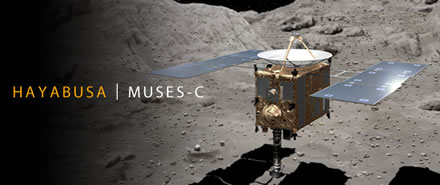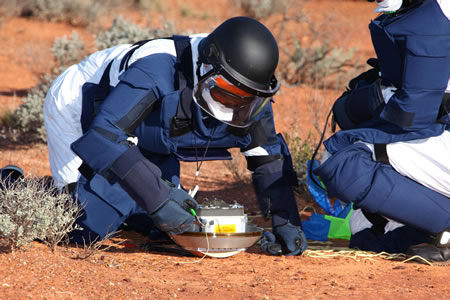Japanese Asteriod Explorer Hayabusa Returns Earth
 |
| A helicopter found the capsule about an hour after the return |
A capsule thought to contain the first samples grabbed from the surface of an asteroid has returned to Earth.The Japanese Hayabusa container hit the top of the atmosphere just after 1350 GMT, producing a bright fireball over southern Australia.It had a shield to cope with the heat of re-entry and a parachute for the final drop to the ground.A recovery team later reported they had identified the landing zone in the Woomera Prohibited Range.
"We just had a spectacular display out over the Outback skies of South Australia," said Professor Trevor Ireland, from the Australian National University, who will get to work on the samples
"We could see the little sample-return capsule separate from the main ship and lead its way in; and [we] just had this magnificent display of the break-up of Hayabusa," he told the Media.
For about seven years since its launch by an M-V Launch Vehicle in May 2003, the HAYABUSA successfully completed a great achievement by landing on the asteroid "ITOKAWA," gathering rocks there, and returning to the Earth with them while overcoming various troubles.
video
HAYABUSA - The Spacecraft that touched an Asteriod
 |
The Hayabusa mission was launched to asteroid Itokawa in 2003, spending three months at the 500m-long potato-shaped space rock in 2005.
The 510-kilogram (950-pound) Hayabusa spacecraft rendezvoused with asteroid Itokawa in September 2005. Over the next two-and-a-half months, the spacecraft made up-close and personal scientific observations of the asteroid's shape, terrain, surface altitude distribution, mineral composition, gravity, and the way it reflected the sun's rays. On Nov. 25 of that year, Hayabusa briefly touched down on the surface of Itokawa. That was only the second time in history a spacecraft descended to the surface of an asteroid (NASA's Near Earth Asteroid Rendezvous-Shoemaker spacecraft landed on asteroid Eros on Feb. 12, 2001). Hayabusa marked the first attempt to sample asteroid surface material.
The spacecraft departed Itokawa in January 2007. Analysis has shown the Hayabusa spacecraft's capture mechanism malfunctioned at the moment it was supposed to pick up the asteroid rock fragments.
However, Japanese space agency (Jaxa) officials remain confident of success. They say a lot of dust would have been kicked up when Hayabusa landed on the space rock to make the grab, and some of this material must have found its way inside the probe.
The Journey Home..
 |
| Scientists Working on The Retrieved Capsule |
The road home for the technology demonstrator has been a long one, with several anomalies encountered along the way.
On the journey home, the Hayabusa team had to work around communication drop-outs and propulsion glitches.But each time an issue came up, the scientists and engineers working on the project managed to find an elegant solution. NASA's JPL has closely collaborated with JAXA to facilitate the smooth reentry of Hayabusa. "This is the second highest velocity re-entry of a capsule in history," said Peter Jenniskens, a SETI Institute scientist at NASA's Ames Research Center in Moffett Field, Calif. "This extreme entry speed will result in high heating rates and thermal loads to the capsule's heat shield. Such manmade objects entering with interplanetary speed do not happen every day, and we hope to get a ringside seat to this one."
Just three hours before the spacecraft began its plunge into Earth's atmosphere, it pushed the sample capsule out in front.The main spacecraft was destroyed during the descent, accounting for most of the spectacular light show south Australians saw in the night sky.
The container, on the other hand, was equipped with a shield made from carbon phenolic resin which is capable of enduring temperatures that were expected to reach 3,000C on the re-entry.
Radar tracking and a beacon in the canister itself were used by the recovery team to locate the parachute drop-point.
Hayabusa team members will retrieve it and transport it to JAXA's sample curatorial facility in Sagamihara, Japan. There, Japanese astromaterials scientists, assisted by two scientists from NASA and one from Australia, will perform a preliminary cataloging and analysis of the capsule's contents.
"This preliminary analysis follows the basic protocols used for Apollo moon rocks, Genesis and Stardust samples," said Mike Zolensky, a scientist at NASA's Astromaterials Research and Exploration Science Directorate at the Johnson Space Center, Houston. "If this capsule contains samples from the asteroid, we expect it will take a year to determine the primary characteristics of the samples, and learn how to best handle them. Then the samples will be distributed to scientists worldwide for more detailed analysis."
